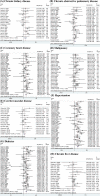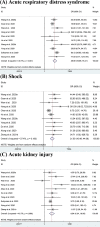Clinical determinants of the severity of COVID-19: A systematic review and meta-analysis
- PMID: 33939733
- PMCID: PMC8092779
- DOI: 10.1371/journal.pone.0250602
Clinical determinants of the severity of COVID-19: A systematic review and meta-analysis
Abstract
Objective: We aimed to systematically identify the possible risk factors responsible for severe cases.
Methods: We searched PubMed, Embase, Web of science and Cochrane Library for epidemiological studies of confirmed COVID-19, which include information about clinical characteristics and severity of patients' disease. We analyzed the potential associations between clinical characteristics and severe cases.
Results: We identified a total of 41 eligible studies including 21060 patients with COVID-19. Severe cases were potentially associated with advanced age (Standard Mean Difference (SMD) = 1.73, 95% CI: 1.34-2.12), male gender (Odds Ratio (OR) = 1.51, 95% CI:1.33-1.71), obesity (OR = 1.89, 95% CI: 1.44-2.46), history of smoking (OR = 1.40, 95% CI:1.06-1.85), hypertension (OR = 2.42, 95% CI: 2.03-2.88), diabetes (OR = 2.40, 95% CI: 1.98-2.91), coronary heart disease (OR: 2.87, 95% CI: 2.22-3.71), chronic kidney disease (CKD) (OR = 2.97, 95% CI: 1.63-5.41), cerebrovascular disease (OR = 2.47, 95% CI: 1.54-3.97), chronic obstructive pulmonary disease (COPD) (OR = 2.88, 95% CI: 1.89-4.38), malignancy (OR = 2.60, 95% CI: 2.00-3.40), and chronic liver disease (OR = 1.51, 95% CI: 1.06-2.17). Acute respiratory distress syndrome (ARDS) (OR = 39.59, 95% CI: 19.99-78.41), shock (OR = 21.50, 95% CI: 10.49-44.06) and acute kidney injury (AKI) (OR = 8.84, 95% CI: 4.34-18.00) were most likely to prevent recovery. In summary, patients with severe conditions had a higher rate of comorbidities and complications than patients with non-severe conditions.
Conclusion: Patients who were male, with advanced age, obesity, a history of smoking, hypertension, diabetes, malignancy, coronary heart disease, hypertension, chronic liver disease, COPD, or CKD are more likely to develop severe COVID-19 symptoms. ARDS, shock and AKI were thought to be the main hinderances to recovery.
Conflict of interest statement
The authors have declared that no competing interests exist.
Figures





References
-
- World Health Organization. Coronavirus disease (COVID-19) outbreak, https://www.who.int/emergencies/diseases/novel-coronavirus-2019/interact... (accessed 10 August 2020).
-
- World Health Organization. Coronavirus disease (COVID-19) outbreak, https://www.who.int/emergencies/diseases/novel-coronavirus-2019/situatio... (accessed 9 March 2021).
-
- Rodriguez-Morales AJ, Cardona-Ospina JA, Gutiérrez-Ocampo E, Villamizar-Peña R, Holguin-Rivera Y, Escalera-Antezana JP, et al.. Clinical, laboratory and imaging features of COVID-19: A systematic review and meta-analysis. Travel Med Infect Dis. 2020/03/18. 2020;34: 101623. 10.1016/j.tmaid.2020.101623 - DOI - PMC - PubMed
Publication types
MeSH terms
LinkOut - more resources
Full Text Sources
Other Literature Sources
Medical

